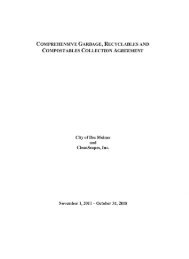CITY OF DES MOINES SHORELINE MASTER PROGRAM
CITY OF DES MOINES SHORELINE MASTER PROGRAM
CITY OF DES MOINES SHORELINE MASTER PROGRAM
You also want an ePaper? Increase the reach of your titles
YUMPU automatically turns print PDFs into web optimized ePapers that Google loves.
Des Moines Shoreline Master Program<br />
Every two years the PSAT partnership develops a plan to guide their work. The 2005-2007 plan<br />
provides a total of $182 million dollars funded through state agency budgets to address eight<br />
priority areas:<br />
• Clean up contaminated sites and sediments;<br />
• Reduce continuing toxic contamination and prevent future contamination;<br />
• Reduce the harm from stormwater runoff;<br />
• Prevent nutrient and pathogen pollution caused by human and animal wastes;<br />
• Hood Canal: a geographic priority for 2005-2007;<br />
• Protect shorelines and other critical areas that provide important ecological functions;<br />
• Restore degraded nearshore and freshwater habitats; and<br />
• Conserve and recover orca, salmon, forage fish, and groundfish (PSAT, 2005).<br />
4.4.2 Puget Sound Nearshore Project (PSNP)<br />
The Puget Sound Nearshore Project (PNSP) (also referred to as the Puget Sound Nearshore<br />
Ecosystem Restoration Project (PSNERP)) is a large-scale, multi-agency initiative to address<br />
habitat restoration needs in the Puget Sound basin. Nearshore Project goals are to identify<br />
significant ecosystem problems, evaluate potential solutions, and restore and preserve critical<br />
nearshore habitat. The PSRP represents a partnership between the U.S. Army Corps of Engineers<br />
(Corps), state and federal government organizations, Indian tribes, industries and environmental<br />
organizations.<br />
A General Investigation Reconnaissance Study conducted by the U.S. Army Corps of Engineers<br />
in 2000 (USACOE, 2000) identified a direct link between healthy nearshore habitat and the<br />
physical condition of the shoreline. The study identified several actions that would be central in<br />
restoring nearshore processes to a more natural state:<br />
• Providing marshes, mudflats, and beaches with essential sand and gravel materials;<br />
• Removing, moving and modifying artificial structures (bulkheads, riprap, dikes, tide<br />
gates, etc.);<br />
• Using alternative measures to protect shorelines from erosion and flooding; and<br />
• Restoring estuaries and nearshore habitat such as eelgrass beds and kelp beds (USACOE,<br />
2000; PSNP, 2002).<br />
The PSNERP also provides outreach and guidance materials related to nearshore ecosystem<br />
restoration principals, concepts, and methods of implementation.<br />
Department of Ecology approval effective November 1, 2010<br />
36 Adopted by City of Des Moines Ordinance No. 1502



